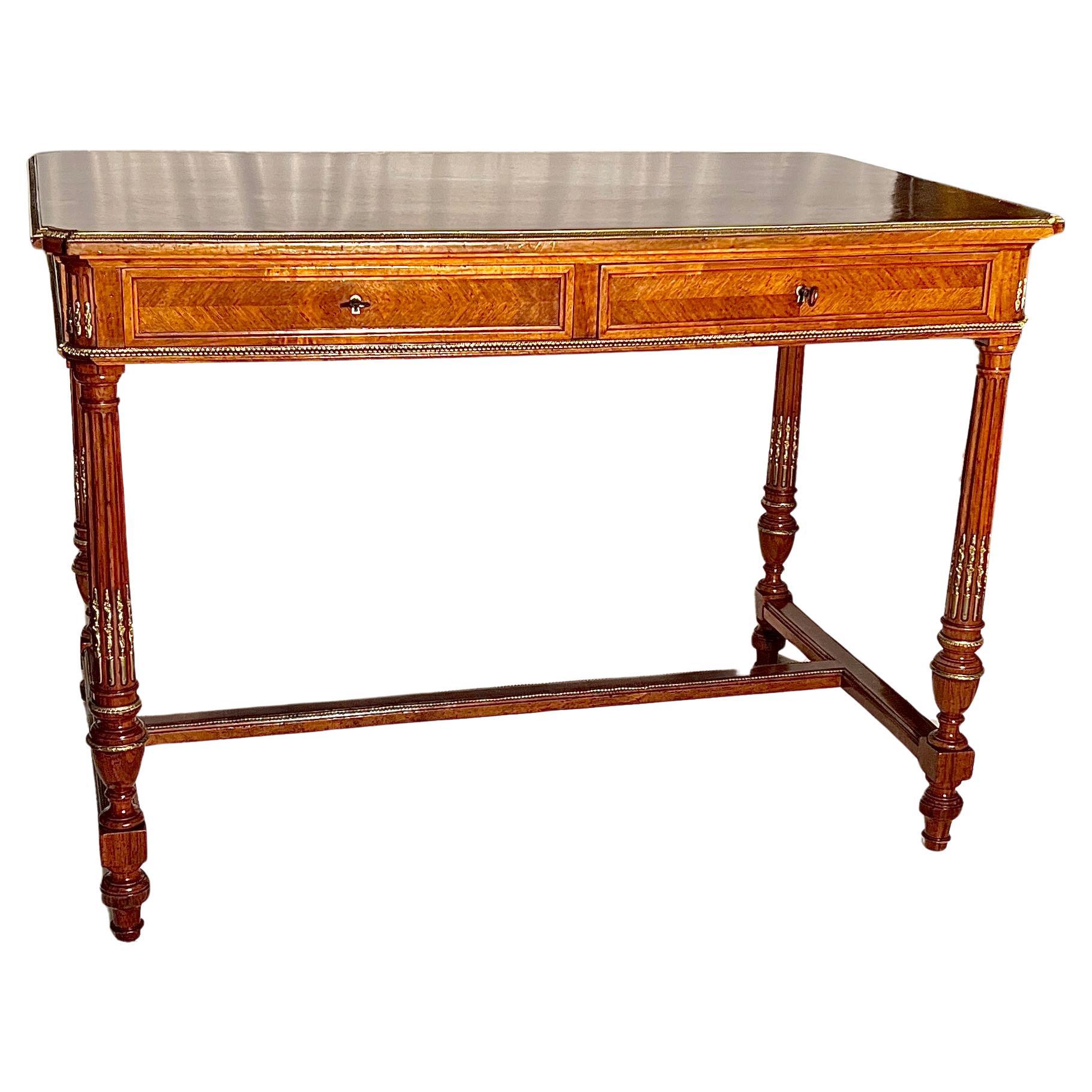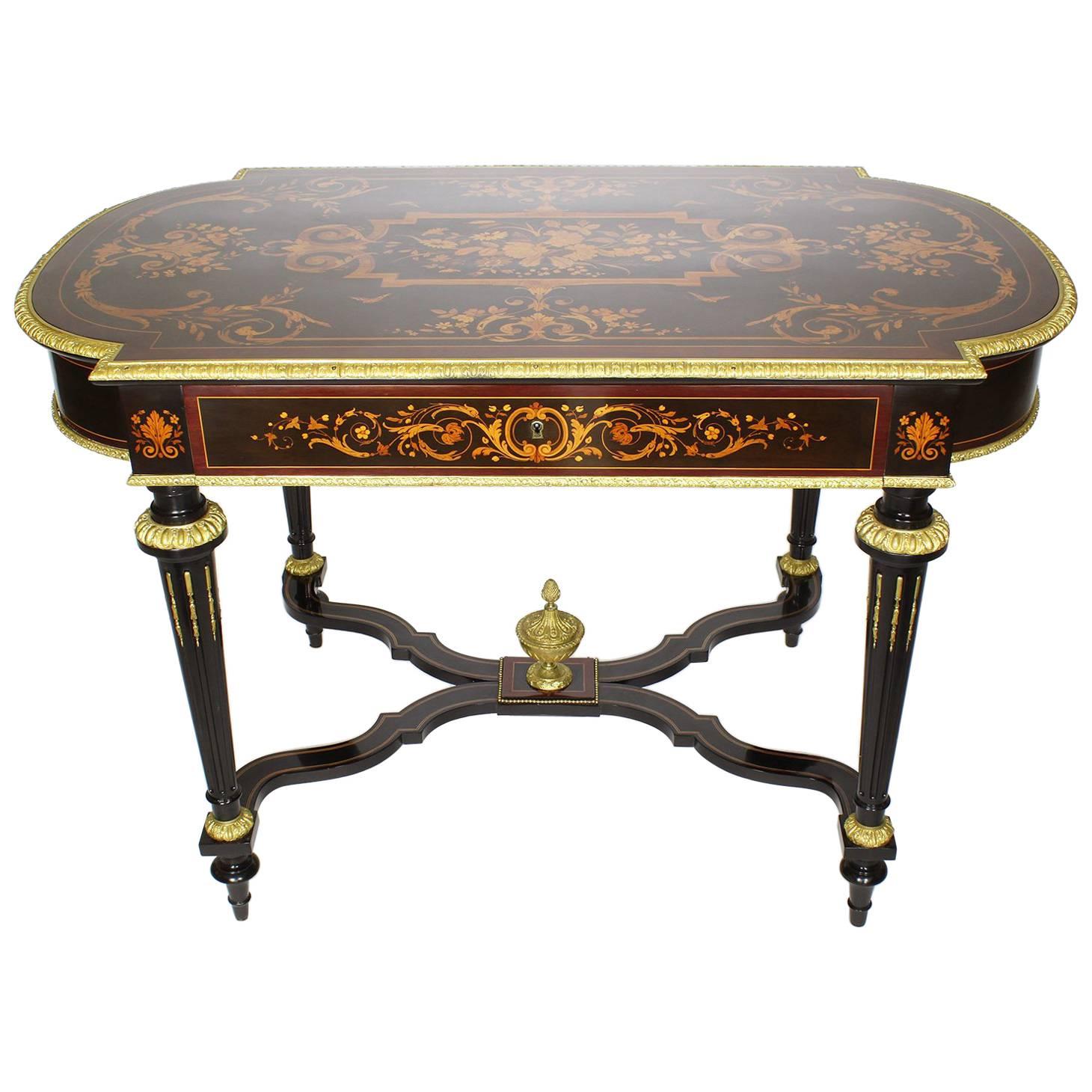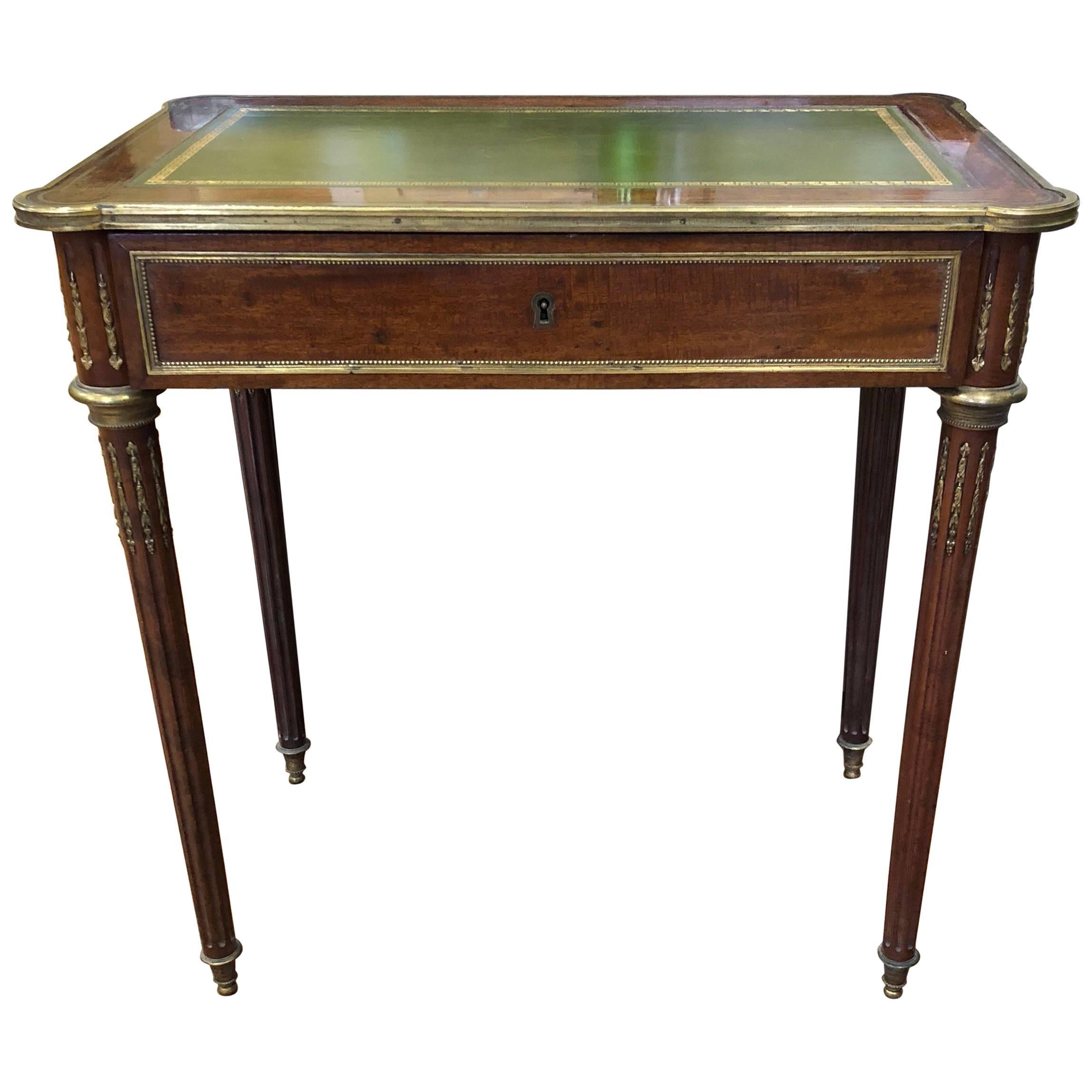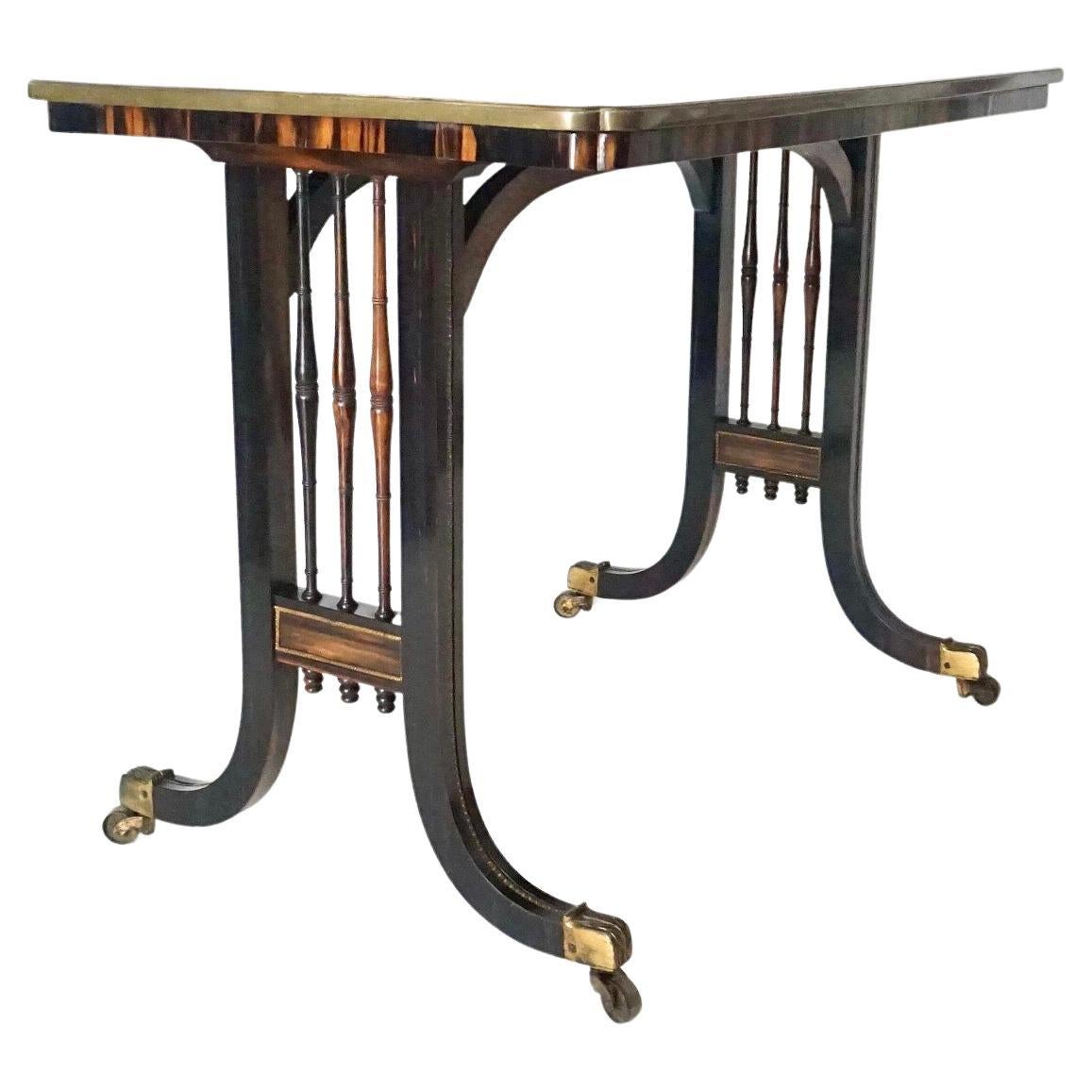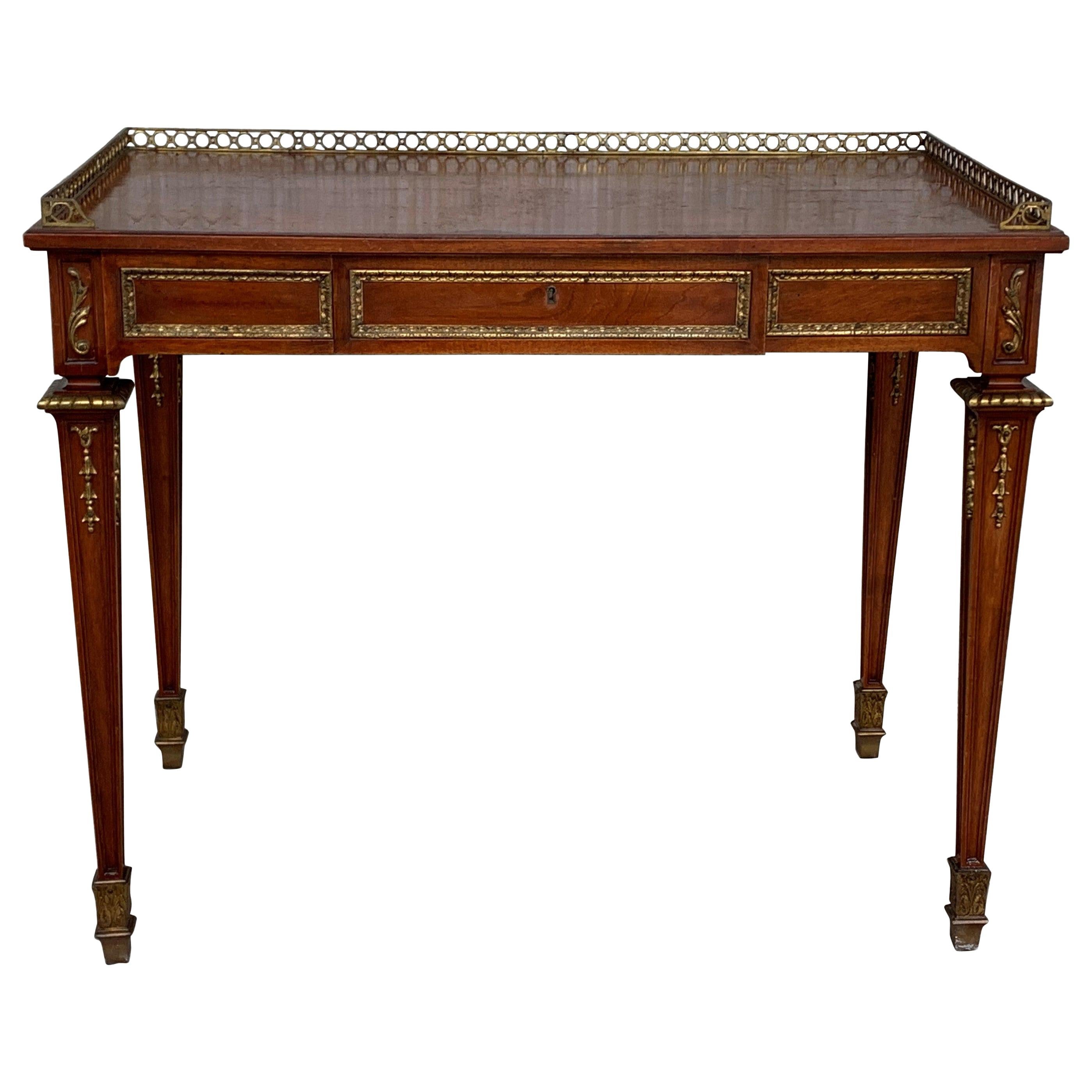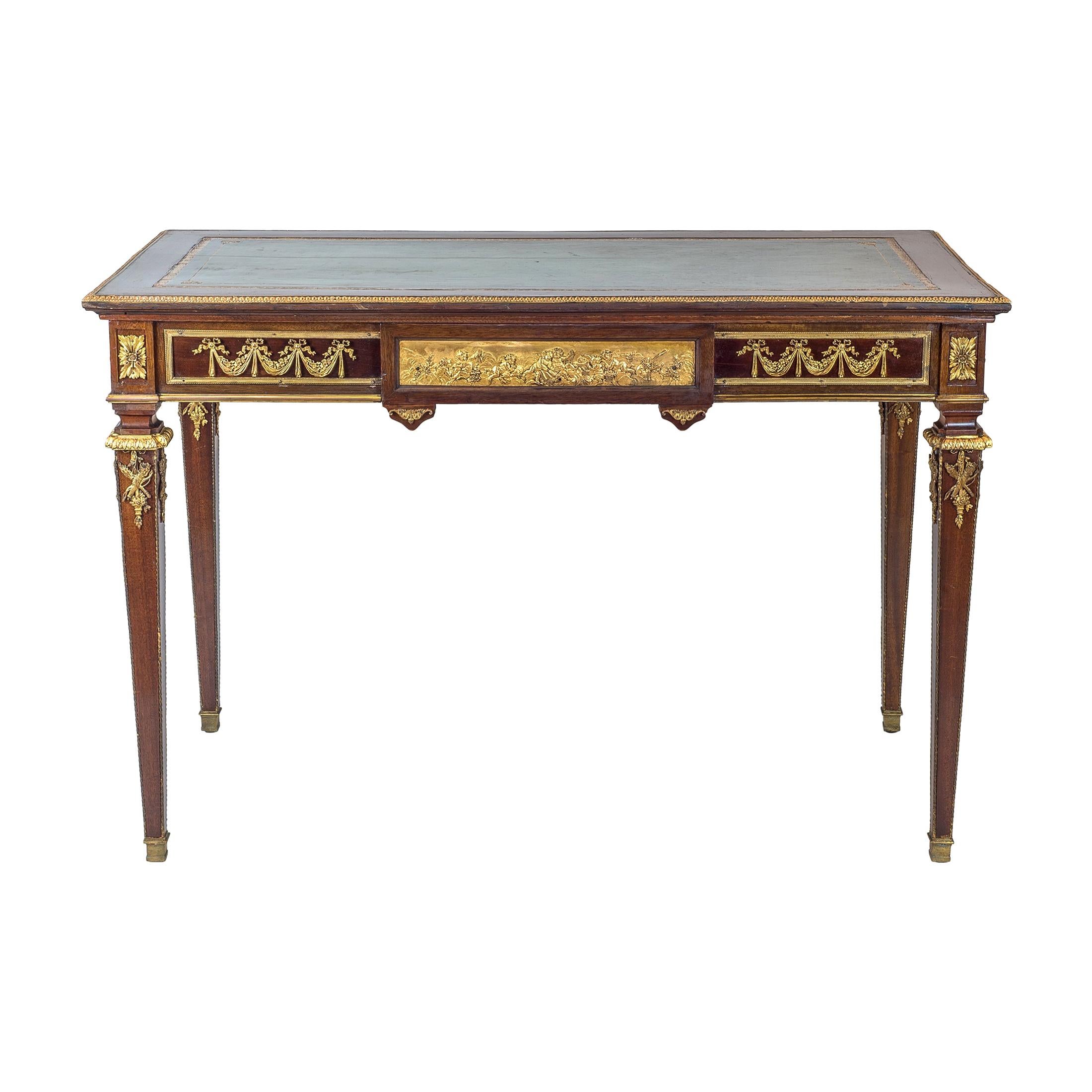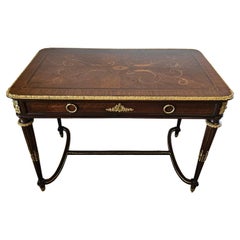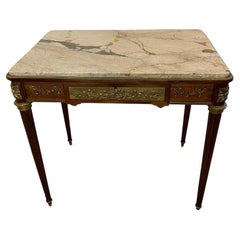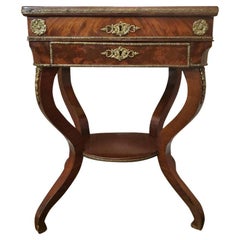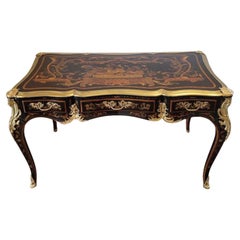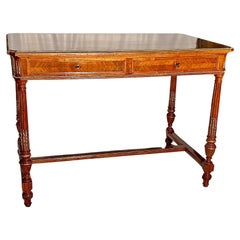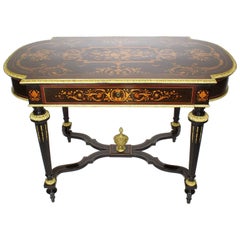Items Similar to Antique French Louis XVI Style Kidney Trestle Gilt Brass Gallery Writing Table
Want more images or videos?
Request additional images or videos from the seller
1 of 21
Antique French Louis XVI Style Kidney Trestle Gilt Brass Gallery Writing Table
$1,995
£1,541.48
€1,782.10
CA$2,819.08
A$3,161.78
CHF 1,655.78
MX$38,418.77
NOK 21,025.60
SEK 19,933.75
DKK 13,302.45
About the Item
Add luxurious elegance and sophistication with this exquisite French Louis XVI style kingwood marquetry table a ecrire (writing table).
Dating to the late 19th / early 20th century, exceptionally executed in exotic kingwood, having a finely detailed floral bouquet marquetry inlaid kidney-shaped top with crossbanded border and undulating pierced bronze dore gallery, over pull-out slide with inset green leather writing surface, flanked by two dovetailed drawers, rising on shaped trestle base.
Dimensions: (approx)
28.5" High, 37" Wide, 15" Deep
Ideal size and proportions for a variety of different uses, including as a desk, side table, hall console, sofa table, and more!
Condition:
Very good antique condition with beautifully aged warm rich patina and lustrous glow. Wear commensurate with age and use, including scattered minor nicks, light abrasions, lightly patinated brass, etc.. delivered cleaned, hand waxed, polished, ready for immediate use and generational enjoyment!
- Dimensions:Height: 28.5 in (72.39 cm)Width: 37 in (93.98 cm)Depth: 15 in (38.1 cm)
- Style:Louis XVI (In the Style Of)
- Materials and Techniques:
- Place of Origin:
- Period:
- Date of Manufacture:circa 1900
- Condition:Wear consistent with age and use. Very good antique condition with beautifully aged warm rich patina & lustrous glow. Wear commensurate with age & use, including scattered minor nicks, abrasions, lightly patinated brass, etc.. delivered cleaned, hand waxed, polished, ready for use!
- Seller Location:Forney, TX
- Reference Number:1stDibs: LU5977245800642
About the Seller
4.8
Platinum Seller
Premium sellers with a 4.7+ rating and 24-hour response times
Established in 2013
1stDibs seller since 2021
294 sales on 1stDibs
Typical response time: <1 hour
- ShippingRetrieving quote...Shipping from: Forney, TX
- Return Policy
Authenticity Guarantee
In the unlikely event there’s an issue with an item’s authenticity, contact us within 1 year for a full refund. DetailsMoney-Back Guarantee
If your item is not as described, is damaged in transit, or does not arrive, contact us within 7 days for a full refund. Details24-Hour Cancellation
You have a 24-hour grace period in which to reconsider your purchase, with no questions asked.Vetted Professional Sellers
Our world-class sellers must adhere to strict standards for service and quality, maintaining the integrity of our listings.Price-Match Guarantee
If you find that a seller listed the same item for a lower price elsewhere, we’ll match it.Trusted Global Delivery
Our best-in-class carrier network provides specialized shipping options worldwide, including custom delivery.More From This Seller
View AllMaison Forest Signed French Louis XVI Style Writing Table - Late 19th Century
By Maison Forest
Located in Forney, TX
A rare and very fine quality 19th century French bureau plat by renowned Parisian ébéniste Maison Forest.
Maison Forest is one of the most famous french cabinetmakers of the 19th a...
Category
Antique Late 19th Century French Louis XVI Desks and Writing Tables
Materials
Bronze, Ormolu
Antique French Louis XVI Bronze Mounted Writing Table
By Jean-Henri Riesener, François Linke, Claude Michel Clodion
Located in Forney, TX
A striking French antique Louis XVI style gilt bronze mounted writing table made after the model by cabinetmaker to King Louis XVI and Marie Antoinetteean, important ébéniste Jean-Henri Riesener (German/French, 1734-1806) and later reproduced by Francois Linke (French, 1855-1946). Signed bronze mounts, Marco.
Born in France in the early 19th century, possibly during the late 18th century Louis XVI period, most likely Parisian work, exquisitely hand-crafted in several woods of contrasting colors including walnut and mahogany to create fine wooden inlays and parquetry detailing. The original partially inset marble top with dramatic veining sits above a flat sided break-fronted front and back adorned with fine bas-relief bronze plaques cast adorned with putti cherubs in the manner of the French sculptor Clodion (Claude Michel, 1738-1814).
The centered front bronze panel disguises a single frieze drawer with dovetail joinery and original key, flanked by gilded bronze foliate mounted rounded corners, a simulated panel drawer to the reverse, embellished on all four sides by intricate finely chiseled, chased and sculpted scrolling laurel ribbon and garland swag ormolu mounts, patinated brass running ornamentation, rising elegantly on four bronze dore ring mounted straight tapering fluted legs, terminating in patinated bronze toupie feet sabots. Signed / marks; the bronzes are stamped / incised Marco.
PROVENANCE / ACQUISITION:
Property from the Collection of Gloria Monnet Nicholson, Tulsa, Oklahoma.
Acquired from highly reputable auction house Heritage Auctions, Dallas, Texas. Fine Furniture & Decorative Arts Signature Auction, catalog #8085.
Dimensions: (approx)
30" High, 32" Wide 21.5" Deep
As warm and attractive as it is useful, having the ideal size and proportions for a variety of different uses, including as a side table, petite bureau...
Category
Antique Early 19th Century French Louis XVI Desks and Writing Tables
Materials
Marble, Brass, Bronze
19th C. French Charles X Restoration Period Sewing Stand Work Table
Located in Forney, TX
A scarce period Charles X (1818-1834) French Restoration mahogany travailleuse sewing (thread stand - side table - jewelry dressing table) with light, warm, beautifully aged patina.
Born in France in the early 19th century, almost certainly Parisian work, exquisitely hand-crafted, this exceptionally executed example features ornate gilt bronze ormolu mounts, escutcheons, and elaborate gilt metal trim. Having a highly figured light mahogany hinged lid top, lifting open to reveal a striking finished interior with divided compartments and original inset mirror plate. The conforming rectangular case fitted with a faux drawer front over a dovetailed drawer with sectioned interior. Elegantly rising on oval-shaped medial shelf stretcher-joined curvacious legs.
Dimensions (approx):
27" High, 20" Wide, 13.5" Deep
Stunning light almost blonde antique mahogany coloring and mellow warm tone, superb wood grain detail, and charming, beautifully aged patina over the whole. Great shape overall. Retaining original antique character marks, wear consistent with age and indicative of minimal use, nothing that detracts from the aesthetics or functionality, but only adds to the overall authenticity, refined elegant warmth, luxurious sophistication, and cozy unpretentious rustic elegance.
Delivered cleaned, hand waxed, polished French patina finish, ready for immediate use and generational enjoyment!
What is Charles X style:
The comte d’Artois – or Charles X - was the son of the dauphin Louis-Ferdinand de Franc and Marie-Josèphe de Saxe. He succeeded his two brothers Louis XVI and Louis XVIII and became the King of France in 1824. Thirty years after the French Revolution, he wanted to embody the return of monarchy and became the leader of the catholic party . As the previous kings, he was crowned in 1825 but he was soon overthrown by the revolution in July, 1830, called "Trois Glorieuses". He left then for England, Scotland, Prague and Istria where he died in 1836.
Charles X style lasted from 1818 to 1834 and happened during the Bourbon Restoration (French Restoration). This style did not replace totally the style of furniture from the French Empire but it was different from the formalism in the Napoleonic era, during which strictness and simplicity were inspired by Greco-Roman art. Indeed, artistic fields flourished. In terms of furniture, this renewal was suggested by the softening of shapes. Even though the simple aspect from the French Empire was still visible, shapes became curvier with volutes and arabesques. Another distinction is the loss of the massive aspect of furniture and the decrease of dimensions in order to decorate smaller appartments. Handling ability and comfort were key-words in the making of furniture. Apartments had essential elements such as chests of drawers, big rounded tables in the dining room, desks or secretaries, armoires and even dressing tables, comfortable fainting couches in the living room, small tables, pedestal tables, as well as gondola chairs. The wavy aspect of the latters certainly represent Charles X style the best.
One of the most emblematic features of this style is the use of bois clairs – light woods in warm blond tones - and indigenous woods that are varnished in order to highlight the grains. Bird's-eye maple, ash trees, plane trees, yew trees, beech trees, olive trees and cedar trees were most likely to be used. Indeed, at the beginning of the 19th century dark woods were hard to find. In 1806, the Napoleon’s Continental System was established in order to ruin the United Kingdom by preventing the country from any business with the rest of Europe. Therefore craftsmen had to find alternatives from mahogany which was the most commonly used material at this time. After 1815, the import of wood was even more difficult because of peace treaties and the European political situation, which contributed to the popularity of the bois clairs and indigenous woods. The furniture was often decorated with fine inlays made out of dark wood representing foliage, which contrasted with the veneer. Even though these patterns can look like bronze decorations from the Empire era, they were far more simple and did not represent any military or mythological attributes. On the tables, trays were sometimes made out of marble as in the French Empire, but it was often put aside and inlaid veneer, Verre Eglomisé – a type of glass with a mirror finish –, mirror or porcelain from Sèvres or Paris were more likely to be used.
Decorative elements from the Monarchy were highly appreciated again as they suggested luxury. Indeed, marquetry work was particularly fashionable - Boulle marquetry thrived around 1820 as the works of the Levasseur family can show. In the same way, draperies and trimmings referred to the monarchist splendour. Fabrics were often white – the traditional colour of the Bourbons – or light coloured as oppposed to the typical green from the Napoleonic era.
One of the most symbolic figures from this period of time might be Jean-Jacques Werner (1791-1849), a cabinetmaker who worked for prestigious clients such as the Duchesse de Berry who was Charles’s step-daughter. His works can be seen at the Musée des Arts Décoratifs and at the Grand Trianon in the Palace of Versailles. The duchess’s appartments situated at the pavillon de Marsan and at the Palais de Saint Cloud illustrate Charles X style the best with furniture made out of bois clairs and ornamented with dark wood patterns or fine gold decorations.
Chales X style allows a transition between the sobriety of the Empire style and the abundant aspect of Louis-Philippe style. The gothic style started at this time through the "style à la cathédrale", inspired by religious architecture, which thrived from 1827 to 1830. Indeed, at the beginning of the 19th century, Romanticism put the spotlight on the Middle Ages. Cabinetmakers were not inspired by the medieval furniture but rather by architectural elements of churches and cathedrals. For instance the backs of chairs were decorated with arches shaped like rib and serration. In the same way, before Charles X abdicated, pieces of furniture were made out of dark woods – such as mahogany, which was used again in France – and were inlaid with light wood. Romanticism also influenced the layout of furniture in appartments to suggest movement through a mix of various styles, various shapes and various sizes, as opposed to the static aspect of Neoclassicism. The start of industrialisation and mechanisation also influenced this style as early technical developments led to the production of pieces of furniture in series.
Credit:
Marc Maison
Bibliography:
FANIEL Stéphane (Dir.), Le Dix-neuvième Siècle Français, Collection Connaissance des Arts, 1957, Hachette
SASSONE, Adriana Boidi, Furniture from Rococo to Art Deco, 2000, Evergreen
--
Extremely versatile:
As warm and attractive as it is useful, this remarkable antique table having the ideal size and small proportions for a variety of different uses, including as a side table, accent or occasional table, tall sofa...
Category
Antique Early 19th Century French Charles X End Tables
Materials
Bronze, Ormolu
French Louis XV Style Gilt Bronze Marquetry Bureau Plat
By Jacques Dubois
Located in Forney, TX
French Perfection! A most impressive and very fine quality vintage Louis XV style ormolu mounted marquetry inlaid bureau plat.
Exquisitely hand-crafted in the manner of important...
Category
20th Century Louis XV Desks and Writing Tables
Materials
Bronze, Ormolu
Krieger Signed Antique French Empire Tiered Tea Tray Table
By Maison Krieger
Located in Forney, TX
A rare and most attractive French gilt bronze ormolu mounted mahogany tiered tea table with removable tray top by important Parisian furniture maker Maison ...
Category
Early 20th Century French Louis XVI Tray Tables
Materials
Brass, Bronze, Ormolu
French Louis XV Style Kingwood Parquetry Bonheur du jour
Located in Forney, TX
Sophisticated French elegance at its finest, we offer this rare Belle Époque period light and graceful bonheur du jour (writing table - petite / lady's desk) with beautifully aged patina.
Finely hand crafted in France in the early 20th century, finished in luxurious Louis XV taste, this exceptionally executed Parisian work features exotic Kingwood parquetry inlays, an exquisitely shaped cartonnier (an ornamental box...
Category
Early 20th Century Belle Époque Desks and Writing Tables
Materials
Bronze, Ormolu
You May Also Like
Antique French Louis XVI Gold Bronze Mounted Kingwood Writing Table, Circa 1885
Located in New Orleans, LA
Antique French Louis XVI Gold Bronze Mounted Kingwood Writing Table, Circa 1885.
Category
Antique Late 19th Century French Desks and Writing Tables
Materials
Bronze
French 19th Century Louis XVI Style Gilt Bronze-Mounted Center, Writing Table
Located in Los Angeles, CA
A fine French 19th century Louis XVI style ebonized gilt bronze-mounted tulipwood, kingwood and fruitwood floral marquetry single-drawer center table, desk or writing table. The ornately decorated marquetry top, centered with a floral bouquet, butterflies, scrolls and acanthus. The raised on four fluted ebonized legs surmounted with gilt-bronze spigots...
Category
Antique Early 1900s French Louis XVI Center Tables
Materials
Bronze
$14,850 Sale Price
24% Off
Louis XVI Style Brass Inlaid Mahogany Desk, 20th Century
Located in Spencertown, NY
Louis XVI brass inlaid mahogany desk with parcel-gilt and green leather inset top. The mahogany veneered on oak.
With a single drawer. Lock not working.
Category
20th Century French Louis XVI Desks and Writing Tables
Materials
Wood
English Regency Brass Mounted Exotic Woods Writing Table, Gillows, circa 1820
By Gillows of Lancaster & London
Located in Kinderhook, NY
An exceptional circa 1820 English regency period rectangular-form writing or occasional table attributed to Gillows having brass bound cusped-corner top with ebony line inlay and satinwood feather-banding surrounding center field of bookmatched amboyna, the double elliptical high arched stretchers joining gilt-brass-mounted end supports having turned calamander spindles and braces issuing turned finials between ebony downswept legs ending in acanthus-leaf-cast brass casters.
Several 'spindle end' writing tables were featured in the 'Gillows Estimate Sketch Book' of 1818, and a table of similar end supports stamped GILLOWS LANCASTER is illustrated in Susan Stuart's 'Gillows of Lancaster and London 1730-1840', Vol. I., Woodbridge: Antique Collectors’ Club, 2008. pl. 329, p. 301, stating "a table frame with spindle ends was supplied in the 1820s by Gillows of London to display marble brought back from the Grand Tour by the Tempests of Broughton Hall...
Category
Antique Early 19th Century English Regency Desks and Writing Tables
Materials
Brass
19th Rectangular Bouillotte Louis XVI Desk Table with Bronze Mounts
Located in Miami, FL
This important writing table is after Jean-Henri Riesener, perhaps the most important furniture maker working in Paris during the reign of Louis XVI. The desk thus demonstrates a cur...
Category
Antique Late 19th Century French Louis XVI Desks and Writing Tables
Materials
Marble, Bronze
Louis XVI Style Gilt-Bronze Mounted Mahogany Writing Table
Located in New York, NY
A fine Louis XVI style ormolu-mounted mahogany bureau plat.
Origin: French
Date: late 19th century
Dimension: H 29 1/4 x W 44 x D 22 3/4.
Category
Antique Late 19th Century French Desks and Writing Tables
Materials
Bronze
More Ways To Browse
French Marquetry Louis Xvi Side Table
French Kidney Table
Louis Xvi Kidney Side Table
Slanted Architect Desk
Spanish Revival Desk
Tanker Table
Victorian Roll Top Desk
Warren Platner Executive Desk
Cavalletto Albini
Crank Desk
Donald Ross
Dunbar Roll Top Desk
Eglomise Desk
Faux Bamboo Desk Leather Top
Henredon Leather Table
Indian Rosewood Desk
J R Griffin
Jacobean Style Desk
